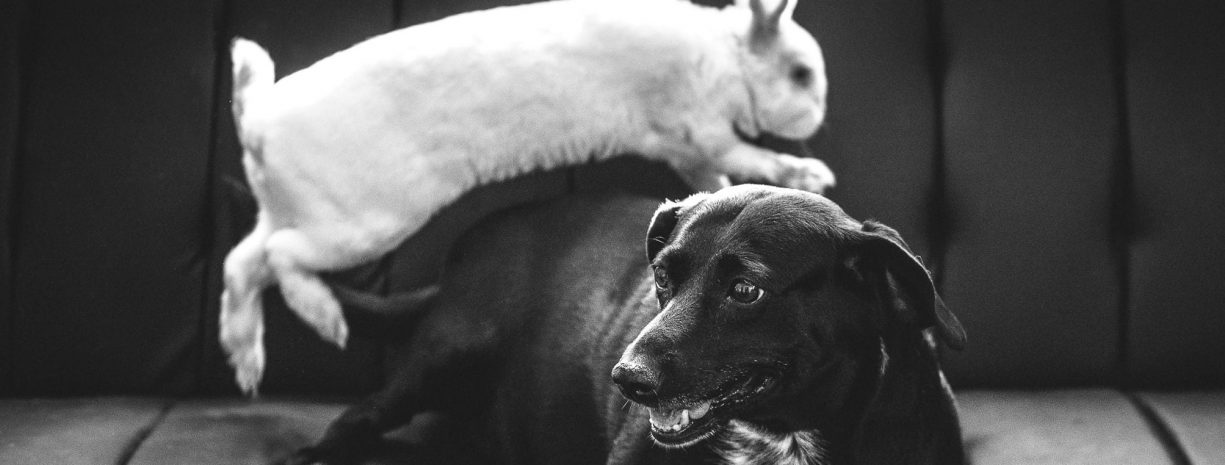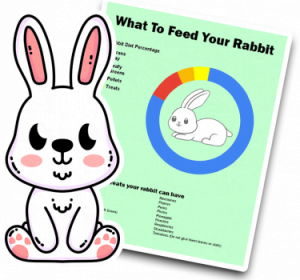
Animals are wonderful and can bring lots of joy, love and laughter into a family. Their very presence can warm even the hardest of hearts.
That’s why if you are a true animal lover, you probably have more than one pet, perhaps a dog and a cat. If you are considering adding a rabbit to the mix — and they are so adorable who could blame you? — here’s what you need to know for all of your pets to live happily together.
The answer to that is it depends on the personality of all the animals involved. Introducing your rabbit to other household pets can be a dicey situation. Sure, it is possible that all of your pets can become friends, but don’t count on it.
So if you are wondering, do rabbits and cats get along? or do rabbits and dogs get along? or perhaps both, you’ll be relieved to know that it certainly is possible, but you have to exercise great care and patience.
Bring the animals together slowly and do not leave them alone together even for a second at first. Rabbits and cats do tend to get along in general, but you do have to use caution when they first meet.
This is because cats are natural predators and rabbits are viewed by them as prey animals. It doesn’t make your cat a the bad guy, it’s just nature’s law and you could find yourself having to ward off these natural instincts in order to prevent disaster.
Fortunately, in the case of your average house cat, rabbits are a lot larger than the prey animals they would usually go after. That means that your average house cat probably won’t take off in hot pursuit of your rabbit the minute he lays eyes on him.
However, if you own a cat that goes outdoors, and just cannot resist going after birds or squirrels at every opportunity, then you likely shouldn’t adopt a rabbit. In the same vein, if you own a territorial or aggressive rabbit, you may have to thing twice before trying to integrate any other pets into the household.
You know the personality of your cat the best. Some cats have the ability to remain extremely calm.
It’s to be expected that they will be a bit puzzled over what this newcomer is doing in their home, but just give them some time to sort it all out in their minds and they will get used to the new presence and it won’t be an issue.
Don’t forget that your rabbit too will require a period of adjustment and will be apt to be a bit leery around the cat. This won’t last, and the odds are that the two will come to accept each other, and probably become friends. Just don’t push things. Allow both of your pets the time they need to safely evaluate the other and determine whether or not they are a threat.
When your two pets are going to meet for the first time, you’d be wise to place a barrier of some type between them, like a fence or cage. Provide the rabbit with a place to hide; a box will do just fine, and be certain that you cat has a place they can dash off to if they should get scared by the rabbit. Be alert and if either animal displays signs of outright fear or nervousness, then bring the meeting to a close and try once more tomorrow. If a rabbit is scared, they will take off and find somewhere to hide, or start thumping with their back legs.
It should only be a few days of setting up these brief interactions and your pets should start to become comfortable around each other. In rare cases this can even happen right away, but this is highly unlikely.
If they start behaving like they normally would when they see each other, and there is no sign of aggression, then you can allow them to interact without a barrier between them. Keep a close on things and be ready to jump in and separate them if there is any hint of trouble.
While it’s great if your pets appear to be just fine with each right from the start, it’s still better to allow them to interact only when you can watch over them, at least for the first couple of months.
You know the saying better safe than sorry. However, once this time has passed, you now can rest assured that your pets have accepted each other.
The situation gets a bit dicier when it comes to bringing rabbits and dogs together than with rabbits and cats. Dogs frequently have very powerful instincts that tell them to chase down small prey animals. Also, there are many types of dogs that were bred with the intent that they would run after rabbits.
If you want to have a dog and a rabbit co-exist peacefully within the same family, you have handle the situation very delicately and keep in mind the animal’s individual personalities.
Usually rabbits and dogs do not take to each other, but it’s not unheard of. A dog and a rabbit may be able to even become friends, especially if the dog has had previous experience with other small animals.
Since your dog may be tempted to chase after or attack your rabbit when they are first introduced, you need to be extremely careful. Your dog should be calm and even-tempered, trained to sit and stay, and you should keep them on a leash. Always be vigilant about any interaction between your two pets.
At first, keep your rabbit and dog apart and at a distance, with a cage or fence between them. Keep your dog on his leash and gradually bring him into the room where the rabbit is, but do not yet allow the dog to approach the cage.
Give it some time and find out how your pets will react to each other. Does your dog become aggressive and want to get at the rabbit? Does the rabbit dash away and find somewhere to hide? If this is the case, promptly take your dog out of the room so that both animals do not remain under stress.
Don’t give up, but continue to try this approach for a few days and hopefully the animals will begin to react more calmly to each other. Once this happens, let the dog get nearer to the rabbit’s area. Still keep him on the leash, and be certain that the rabbit is not shaking with terror as you let the dog get closer.
Once you feel completely confident that your rabbit and dog are no longer wary of each other and are feeling relaxed around each other, and that there will be no aggressive behavior, then you can allow them to get together face to face. Still keep you dog on the leash and be sure that he is going to listen to your commands, and don’t forget to be sure your rabbit has a safe place to run off to.
Be patient, and don’t try and force them together. Let your rabbit approach the dog first and never let down your guard even for an instant. At the least sign of upset in either animal, separate them and wait until another time to try again.
If your furry friends seem to be fine, you can gradually allow them to interact with each other. Stay on the alert and never relax your supervision even for a minute. Over the period of a few weeks let your pets have many of these interactions, but always keep them short so that they get to know each other without anything negative happening.
If they do seem to be ok together, then you can permit them to interact with your dog off of its leash. Just be careful. Even if they should become friends and playmates, you still shouldn’t leave them alone together to avoid accidental injury to the rabbit.

By entering your email address you agree to receive emails from Cottontailclub. We'll respect your privacy and you can unsubscribe at any time.